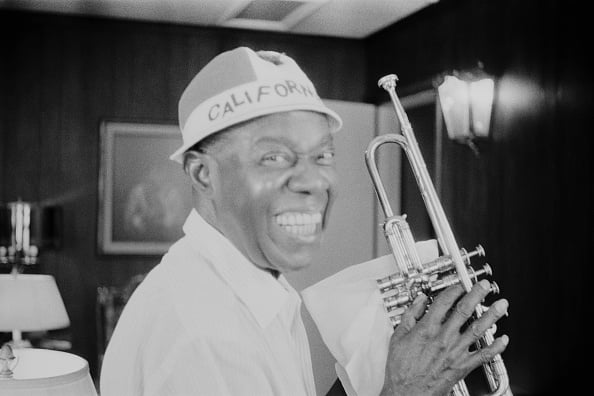What was Louis Armstrong’s Net Worth?
Louis Armstrong was an American jazz trumpeter and singer who had a net worth of $5 million at the time of his death in 1971. That’s the same as around $35 million in today’s dollars. His enduring legacy includes innovations like scat singing and an emphasis on solo performance in jazz. Some of his major accomplishments include iconic performances such as ‘What a Wonderful World’ and ‘Hello, Dolly!’, which remain timeless classics.
Louis Armstrong was born in New Orleans, Louisiana to a very poor family. The grandson of slaves, Armstrong spent his childhood and youth in extreme poverty, especially after his dad took off with another woman. Louis was eleven when he quit school to earn money for his family by singing in a quartet of boys who were performing on the street. This was the year when Armstrong was first introduced with the cornet by cornet player Bunk Johnson. After spending some time in a home for troubled kids, he went on to work at day and develop his music skills at night. He even performed with local jazz bands when he got the chance.
It was Joe “King” Oliver who first recognized Louis’ talent. Mentored by the famous cornet player, Louis did various small jobs for Oliver in return. After his tutor left for Chicago, the world´s center of jazz at the time, Louis started performing on steam boats that were touring down and up the Mississippi River. This helped him hone his skills and even learn how to read music.
In 1922, Louis went to Chicago to join Oliver’s band. In 1924, Louis moved to New York at the request of acclaimed bandleader Fetcher Henderson. In New York he switched to playing the trumpet and developed energetic and creative style that caught the ear of the New York jazz scene. He soon moved back to Chicago to play with his Hot Five and Hot Seven groups, creating such hits as “Potato Head Blues,” “Muggles” and “West End Blues.” The rhythms that he created in the process became the standard and the agenda for jazz musicians for many years to come. As for his trademark music genres, they are dixieland, jazz, swing, traditional pop. Even though he was living in a severely racially divided America, Louis Armstrong managed to cross racial boundaries and became one of the most famous jazz musicians of the 20th century. The world lost a great man and rarely talented musician when Armstrong died in his sleep from a heart attack on July 6, 1971.

Getty Images
/**/
Early Life
Armstrong was born in a neighborhood known as “The Battlefield” in New Orleans, Louisiana. He grew up in poverty, but his early hardships did not deter him from finding solace and passion in music. A significant influence during his childhood was the Karnoffsky family, Lithuanian Jews for whom he worked odd jobs. The family recognized Armstrong’s interest in music and gifted him a cornet, sparking his enduring love for music.
Beginning of Music Career
Armstrong’s career in music formally began when he joined the ‘Kid Ory’s Band’, one of the most well-known bands in New Orleans at the time. His talent for the cornet soon brought him to the attention of the ‘King Oliver Creole Jazz Band’ in Chicago. Joining the band in 1922, he found a mentor in Joe “King” Oliver, who significantly influenced Armstrong’s musical style and helped him make his first major breakthrough.
Fletcher Henderson Orchestra
In 1924, Armstrong moved to New York City and joined the ‘Fletcher Henderson Orchestra’, the premier African American band of that time. His innovative approach to improvisation and solo performance revolutionized jazz, transforming it from a genre rooted in collective improvisation to an art form that highlighted the soloist. Armstrong’s creative solo performances had a lasting impact on the development of jazz.
Invention of Scat Singing
Not only a gifted trumpeter, Armstrong also ventured into singing. He introduced an innovative rhythmic style known as scat singing, which became a hallmark of jazz vocals. His 1926 recording of ‘Heebie Jeebies’ is considered the first-ever scat singing record, marking a significant milestone in his career and jazz history.
Global Fame and Iconic Performances
Armstrong’s fame escalated during the 1930s and 1940s, with numerous appearances in films such as ‘Pennies from Heaven’ and on radio broadcasts. His music reached an international audience, making him a global sensation. His performance of ‘What a Wonderful World’ in 1967 and ‘Hello, Dolly!’ in 1964 are some of his most iconic works, showcasing his remarkable talent and his ability to touch hearts with his music.
Legacy and Influence
Armstrong’s influence extends beyond his music. He was a prolific writer, authoring two autobiographies, several articles, and thousands of letters that provide invaluable insights into his life, jazz, and the social dynamics of his era. Despite facing racial discrimination, his resilience and dedication to his craft broke barriers and paved the way for future generations of Black musicians. His indomitable spirit, love for life, and contribution to music continue to inspire artists and audiences worldwide, solidifying his status as a true icon.
Armstrong passed away on July 6, 1971, but his music and his influence live on.
Read More: World News | Entertainment News | Celeb News
Celebrity Net Worth




